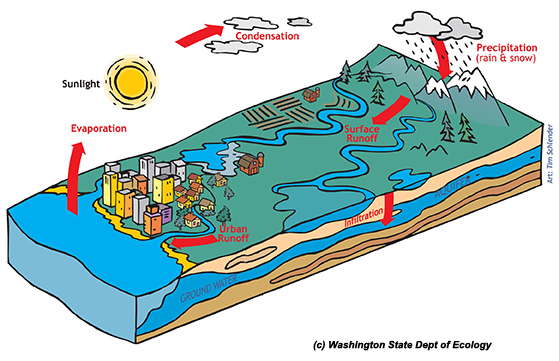Mid Sound works to restore fish and streams in three watersheds:
Click on the links above to learn more about each watershed, the fish that call it home, and the work Mid Sound does to restore the streams there.
What is a Watershed?
A watershed describes an area of land over which rainwater and snow-melt flow into a common set of streams and rivers. The water can flow either over the surface of the land, or through the soil and groundwater.
When some people think of watershed, they only think of the lakes, streams and rivers of the area. But we all live in the watershed – no matter how far you may live from a stream or beach. Rainwater from your neighborhood ultimately ends up in a greater body of water, so anything in our local water can impact whatever is downstream.

Why Are Watersheds Important to Fish?
Fish use the entire stream for their life cycle. They are born high in the steam, and travel down to estuaries. The estuaries allow juvenile fish to adjust from freshwater to salt water, and grow big enough for the ocean. Adult fish later return to the freshwater stream to spawn.
Many of the choices we make about developing land in the watershed affects the health of the water and fish. For instance:
- In natural, healthy watersheds, rainwater will slowly soak into the soil and make its way into the stream. This allows the rainwater to enter at a steady pace, while also being naturally filtered and cleaned by the soil. Streams and rivers can meander through their own zigzagging path, giving them space to correct for any flooding.
- In highly developed areas, rainwater washes over pavement and quickly rushes into the steam. This can lead to flash flooding, and the introduction of any toxics and contaminants picked up along the way. Development often straightens out a river’s winding path as well, increasing its chance of flooding. Abnormally fast and rushing waters can be dangerous for fish, resulting in juveniles being pushed to the ocean before they are ready.
The health of a salmon population is linked to its entire watershed. Our communities have chosen to work together – watershed by watershed – to address the factors that are threatening the salmon and other fish in the area.